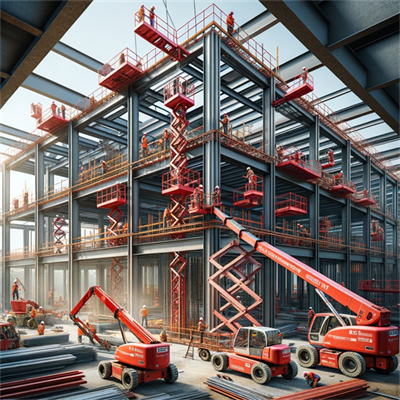Steel Structure Construction
Application Description
In the steel structure construction industry, HERED provides various types of steel structure construction lifts, including scissor lifts and boom lifts suitable for the steel structure construction industry.
In steel structure construction, which involves the construction of buildings, bridges, and other structures with a steel framework, aerial work platforms (AWPs) are essential for providing access at height safely and efficiently. Here's how different AWPs are used in various scenarios within this sector:

Erection of Steel Beams and Columns: Telescopic boom lifts are commonly used during the erection phase to provide workers access to high points for bolting and welding. Their long reach and stability are crucial for the assembly of the steel framework.
Welding and Joining: Articulating boom lifts are preferred when welding or joining steel components at height, particularly in tight spaces or when needing to navigate around existing structures. Their jointed booms allow for precise positioning of the platform.
Installation of Metal Decking and Roofing: Scissor lifts offer a stable platform for workers installing metal decking on floors or roofing materials. Their vertical lift capability is ideal for such tasks that don't require horizontal reach.
Painting and Surface Coatings: For painting and applying protective coatings to steel structures, articulating boom lifts and vertical mast lifts are used. These lifts provide access to various angles of the steelwork for thorough coverage.
Inspection and Quality Control: Vertical mast lifts and portable personnel lifts are often used for quality control inspections. These lifts can be easily maneuvered around a construction site and provide sufficient elevation to closely examine welds and bolts.
General Construction Tasks: For general tasks such as fitting, cladding installation, or electrical work, a variety of AWPs can be used, including smaller scissor lifts and push-around lifts for lower heights and tighter spaces.
Rough Terrain: On construction sites with uneven ground, rough terrain scissor lifts and boom lifts are utilized. They have four-wheel drive and larger tires designed to handle the challenging ground conditions commonly found on construction sites.
These AWPs are chosen for their ability to safely lift workers and their tools to the necessary heights and provide a stable work platform. Safety features such as guardrails, harness attachment points, and emergency descent mechanisms are critical due to the nature of working at height in steel construction. Additionally, because steel construction often involves heavy materials and high torque forces, AWPs used in this sector must be robust and may feature reinforced platforms and enhanced weight capacities.









